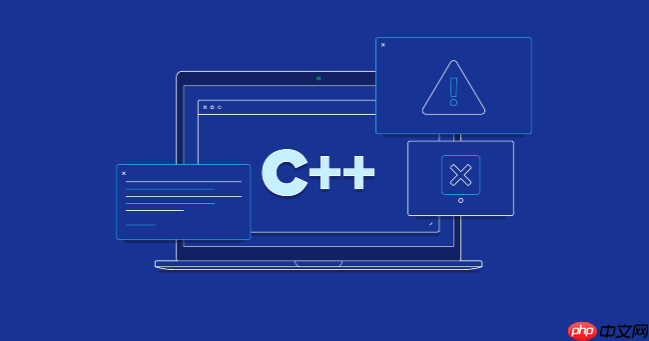c++++結構化并發通過作用域管理任務生命周期,解決資源泄漏和同步問題。1.使用std::jthread自動join線程防止資源泄漏;2.利用std::stop_token安全請求線程停止;3.基于線程池結合std::future和std::packaged_task優化任務調度;4.選擇線程池大小時參考cpu核心數與任務類型,通過公式計算并結合性能測試調整;5.避免死鎖應確保鎖順序一致、縮短持有時間、設置超時機制;6.避免競爭條件可通過互斥鎖、原子操作或無鎖數據結構實現。良好的設計與靜態分析工具也有助于提升并發安全性。

c++結構化并發的核心在于更清晰、可控的任務管理,它通過作用域來管理并發任務的生命周期,避免傳統線程管理中常見的資源泄漏和同步問題。任務調度方案則是在此基礎上,進一步優化任務的執行順序和資源分配,提高并發程序的整體效率。

解決方案
C++20引入的std::jthread和std::stop_token是實現結構化并發的關鍵。std::jthread在線程結束時自動join,防止資源泄漏。std::stop_token則允許安全地請求線程停止,避免強制終止帶來的問題。

任務調度方案可以基于線程池來實現,結合std::future和std::packaged_task可以方便地管理任務的執行結果。
立即學習“C++免費學習筆記(深入)”;

一個簡單的示例:
#include <iostream> #include <thread> #include <vector> #include <future> #include <queue> #include <mutex> #include <condition_variable> class ThreadPool { public: ThreadPool(size_t numThreads) : stop(false) { for (size_t i = 0; i < numThreads; ++i) { workers.emplace_back([this] { while (true) { std::function<void()> task; { std::unique_lock<std::mutex> lock(queueMutex); condition.wait(lock, [this] { return stop || !tasks.empty(); }); if (stop && tasks.empty()) return; task = std::move(tasks.front()); tasks.pop(); } task(); } }); } } template<class F, class... Args> auto enqueue(F&& f, Args&&... args) -> std::future<typename std::result_of<F(Args...)>::type> { using return_type = typename std::result_of<F(Args...)>::type; auto task = std::make_shared<std::packaged_task<return_type()>>( std::bind(std::forward<F>(f), std::forward<Args>(args)...) ); std::future<return_type> res = task->get_future(); { std::unique_lock<std::mutex> lock(queueMutex); if (stop) throw std::runtime_error("enqueue on stopped ThreadPool"); tasks.emplace([task]() { (*task)(); }); } condition.notify_one(); return res; } ~ThreadPool() { { std::unique_lock<std::mutex> lock(queueMutex); stop = true; } condition.notify_all(); for (std::thread& worker : workers) worker.join(); } private: std::vector<std::thread> workers; std::queue<std::function<void()>> tasks; std::mutex queueMutex; std::condition_variable condition; bool stop; }; int main() { ThreadPool pool(4); std::vector<std::future<int>> results; for (int i = 0; i < 8; ++i) { results.emplace_back( pool.enqueue([i]() { std::cout << "Task " << i << " executed by thread " << std::this_thread::get_id() << std::endl; std::this_thread::sleep_for(std::chrono::seconds(1)); return i * 2; }) ); } for (auto& result : results) { std::cout << "Result: " << result.get() << std::endl; } return 0; }
如何選擇合適的線程池大小以優化C++并發性能?
線程池大小的選擇直接影響并發程序的性能。過小的線程池無法充分利用多核CPU的優勢,導致任務排隊等待;過大的線程池則可能引入過多的上下文切換開銷,反而降低性能。
一個常用的經驗法則是:線程池大小 = CPU核心數 * (1 + 等待時間/計算時間)。 其中,等待時間是指任務在等待I/O、網絡或其他資源的時間,計算時間是指任務實際執行計算的時間。
例如,如果任務大部分時間都在等待I/O,那么線程池大小可以適當大于CPU核心數。反之,如果任務是CPU密集型的,那么線程池大小接近CPU核心數即可。
此外,還可以通過性能測試來確定最佳線程池大小。逐步調整線程池大小,并監控程序的吞吐量、響應時間和CPU利用率,找到一個平衡點。
如何使用std::stop_token優雅地停止C++并發任務?
std::stop_token提供了一種非侵入式的方式來請求線程停止。線程可以通過定期檢查std::stop_token::stop_requested()來判斷是否需要停止。
#include <iostream> #include <thread> #include <stop_token> void task(std::stop_token stopToken) { while (!stopToken.stop_requested()) { std::cout << "Task running..." << std::endl; std::this_thread::sleep_for(std::chrono::milliseconds(500)); } std::cout << "Task stopped." << std::endl; } int main() { std::jthread t(task); std::this_thread::sleep_for(std::chrono::seconds(3)); t.request_stop(); // 請求線程停止 return 0; }
在這個例子中,task函數會定期檢查stopToken.stop_requested(),如果返回true,則停止執行。main函數通過t.request_stop()來請求線程停止。std::jthread會在線程停止后自動join,避免資源泄漏。
需要注意的是,std::stop_token只是提供了一種請求停止的機制,線程需要自行處理停止邏輯。
如何避免C++并發編程中常見的死鎖和競爭條件?
死鎖和競爭條件是并發編程中常見的難題。死鎖是指兩個或多個線程互相等待對方釋放資源,導致程序無法繼續執行。競爭條件是指多個線程同時訪問共享資源,導致結果不確定。
避免死鎖的常見方法包括:
避免競爭條件的常見方法包括:
- 使用互斥鎖:使用std::mutex保護共享資源,確保同一時間只有一個線程可以訪問。
- 使用原子操作:對于簡單的共享變量訪問,可以使用std::atomic,避免使用鎖的開銷。
- 使用無鎖數據結構:使用無鎖數據結構,例如無鎖隊列,可以避免鎖帶來的性能瓶頸。
此外,良好的代碼設計和測試也是避免死鎖和競爭條件的關鍵。使用靜態分析工具可以幫助發現潛在的并發問題。



















